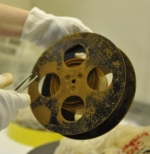Wisconsin Nitrate Film Project
Looking forward, a number of scientific questions remain. Here we have outlined some lingering questions and avenues for future work.
Sample Provenance
 We recognize that our chemical tests and accelerated aging trials utilized a limited sample set. Indeed, the availability of samples is one of the chief difficulties of performing such studies. Future work might employ our same testing protocols on a wider array of cellulose nitrate film stock samples, in order to assess and to establish the generality of our findings. Such studies would either validate our own findings, or, conversely, would point out anomalies therein that could direct future research.
We recognize that our chemical tests and accelerated aging trials utilized a limited sample set. Indeed, the availability of samples is one of the chief difficulties of performing such studies. Future work might employ our same testing protocols on a wider array of cellulose nitrate film stock samples, in order to assess and to establish the generality of our findings. Such studies would either validate our own findings, or, conversely, would point out anomalies therein that could direct future research.
Sheet Film
Far more archives hold heritage nitrate sheet film than nitrate motion picture film, yet various regulations which govern nitrate film are poorly adapted to the storage and handling of nitrate sheet film. It is also the case that the institutions holding sheet film – often state or territorial archives – are less engaged with and aware of the regulatory process.
Members of the National Fire Protection Association (NFPA) Committee on Hazardous Chemicals, which reviews proposed changes to NFPA 40: the Standard for the Storage and Handling of Cellulose Nitrate Film, suggested to Katie Mullen, Preservation Coordinator at the Wisconsin Historical Society (WHS), that specific data from chemical testing of heritage nitrate sheet film would enable the drafting of informed language allowing changes in the storage and handling of these collections. Studies focused just on sheet film or studies that are built around a comparison of sheet film and reel film would thus be of tremendous interest and practical utility to the archival and conservation communities.
Storage Cans
 Previous studies on nitrate film have suggested that iron ions from film canister decomposition could accelerate the decomposition of nitrate film stock. Cans may also play a role in nitrate decay by trapping evolved gases inside. While we were not able to incorporate this potentially important variable into our own study, it might prove to be a useful avenue of future research, particularly given the regulatory restrictions governing the storage of nitrate film.
Previous studies on nitrate film have suggested that iron ions from film canister decomposition could accelerate the decomposition of nitrate film stock. Cans may also play a role in nitrate decay by trapping evolved gases inside. While we were not able to incorporate this potentially important variable into our own study, it might prove to be a useful avenue of future research, particularly given the regulatory restrictions governing the storage of nitrate film.
Regulations Governing Nitrate Film
Our survey of archival professionals, described on the Survey page of this website, demonstrated the disparities between the members of the Association of Moving Image Archivists (AMIA) and the members of the Council of State Archives (CoSA) in terms of level of knowledge and day–to–day practices governing nitrate storage and handling. In the wake of this finding, these two organizations – working with members of the Wisconsin Nitrate Film Project – separately proposed first drafts of revisions for the 2016 version of NFPA 40.
 NFPA proposed the formation of a task group comprised of community members, members of NFPA that work with NFPA 40, and outside archivists to work on proposals for a second draft of revisions. Ultimately, most of the proposed changes were rejected, but NFPA has changed the review cycle for NFPA 40 and has reconvened the NFPA 40 task group, which includes two members of this research group. It may be possible, therefore, to revisit this issue in the future.
NFPA proposed the formation of a task group comprised of community members, members of NFPA that work with NFPA 40, and outside archivists to work on proposals for a second draft of revisions. Ultimately, most of the proposed changes were rejected, but NFPA has changed the review cycle for NFPA 40 and has reconvened the NFPA 40 task group, which includes two members of this research group. It may be possible, therefore, to revisit this issue in the future.
NFPA would welcome more members from the archival community to their nitrate task force, but the archival community must decide how to balance their preservations needs with regulatory restrictions and determine how to further engage with such organizations. Information about how to propose revisions to NFPA 40 can be found on the NFPA website, and any member of the public is able to submit proposals.
Two additional options for seeking regulatory change were suggested by Dr. Neal Langerman, of Advanced Chemical Safety Inc., in the summer of 2015.
First, he proposed that we approach Eastman Kodak Company and ask them to harmonize their Material Safety Data Sheet (MSDS) (most recent edition 2010) on nitrate film with our findings from Chilworth Global. While Kodak’s MSDS claims that the brown powder is shock sensitive, our data from Chilworth demonstrates that it is inert. However, as Kodak no longer manufacturers large quantities of film stock, they may not be obligated to produce a new MSDS.
Langerman further suggested that we could work with Tilak Chandra, Senior Environmental Health Specialist at the University of Wisconsin–Madison, to create a Standard Operating Procedure (SOP) for the handling of cellulose nitrate film on the University of Wisconsin–Madison campus. Our findings about the brown powder could be published as an appendix to that document. We could then take our SOP to the International Standards Organization committee that deals with the handling and storage of nitrate film.
Translating Findings to Practice
Upon peer review of our chemical research, we will be in a better position to suggest practical applications of our findings to improve safety in archival practices.
While the visual analysis methods we investigated did not yield consistent results, it is perhaps worth continuing to investigate whether there are simple tools which archivists could use to discern correlations between physical appearance and the chemical condition of heritage nitrate film.
Finally, while our relative humidity findings cannot be directly translated into storage conditions for many reasons, the archival community would benefit from further investigation in this direction. Our findings may serve as a long-term basis for future work by archivists and conservators with the NFPA to implement regulatory changes. While the timescale of such changes may seem long, the knowledge gained through this study may aid in the continued preservation of our nitrate film heritage with an emphasis on safety.
